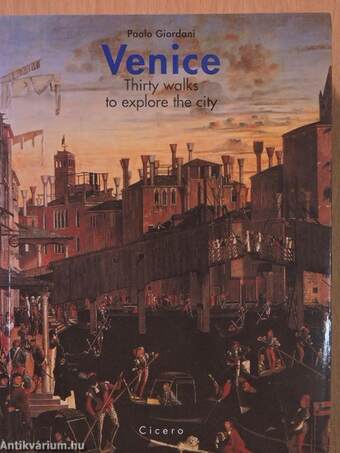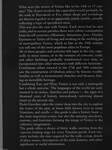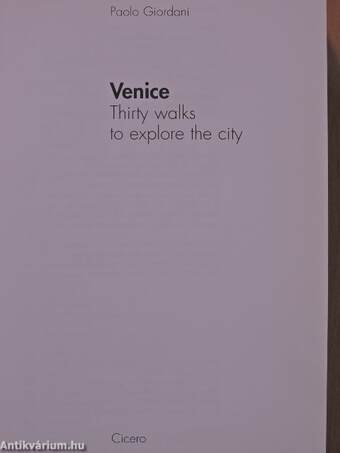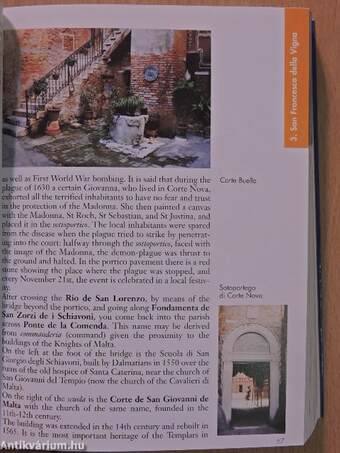1.067.370
kiadvánnyal nyújtjuk Magyarország legnagyobb antikvár könyv-kínálatát

VISSZA
A TETEJÉRE
JAVASLATOKÉszre-
vételek
Venice
Thirty walks to explore the city
| Kiadó: | Cicero |
|---|---|
| Kiadás helye: | Párizs |
| Kiadás éve: | |
| Kötés típusa: | Varrott papírkötés |
| Oldalszám: | 675 oldal |
| Sorozatcím: | |
| Kötetszám: | |
| Nyelv: | Angol |
| Méret: | 19 cm x 14 cm |
| ISBN: | |
| Megjegyzés: | Színes fotókkal. |
naponta értesítjük a beérkező friss
kiadványokról
naponta értesítjük a beérkező friss
kiadványokról
Fülszöveg
What vvere the streets of Venice like in the 14th or 15 century? The closest modern day equivalent would probably be the souk in Marrakesh or Fez, where shops and workshops are thrown together in an apparently untidy jumble, actually reflecting a logic of specialized areas. This was alsó the case with Venice. Each Street had its own crafts, and in certain parishes there were ethnic communities from far-off countries (Albanians, Armenians, Jews , Greeks, Germans or Turks) all living and working in the melting pot of metropolitan Venice, which as late as the 16th century was still one of the most populous cities in Europe. All of these peoples and activities left signs in the city, especially in Street names, or in the remains of convents, scuole, and other buildings gradually transformed over time, or incorporated into other structures with different functions. Continuous úrban renewal in the 17th and 18th centuries saw the construction of fabulous palazzi by famous wealthy families... TovábbFülszöveg
What vvere the streets of Venice like in the 14th or 15 century? The closest modern day equivalent would probably be the souk in Marrakesh or Fez, where shops and workshops are thrown together in an apparently untidy jumble, actually reflecting a logic of specialized areas. This was alsó the case with Venice. Each Street had its own crafts, and in certain parishes there were ethnic communities from far-off countries (Albanians, Armenians, Jews , Greeks, Germans or Turks) all living and working in the melting pot of metropolitan Venice, which as late as the 16th century was still one of the most populous cities in Europe. All of these peoples and activities left signs in the city, especially in Street names, or in the remains of convents, scuole, and other buildings gradually transformed over time, or incorporated into other structures with different functions. Continuous úrban renewal in the 17th and 18th centuries saw the construction of fabulous palazzi by famous wealthy families as well as monumental churches and theaters, leaving an incredible heritage. Combining E'ast and West, Venice is not only a metropolis but a whole universe. The languages of the world are sedimented in its stones, churches and palaces - the signs of a thousand years of history, miraculously surviving almost intact to the present day. Paolo Giordani takes the visitor deep into the city to explore the traces oí the past, at times little known even to many Venetians, and retells - this guide is alsó a history book - the most important events, but alsó the amusing anecdotes, customs, and testivities forming the image of Venice in the collective imagination. The guide offers a choice of thirty walks, starting from the vciporetto landing stage for every Venetian parish. Each itinerary includes the time required for the walk, a map, details of place names, descriptions of the main features, and other significant or useful information. VisszaTémakörök
- Idegennyelv > Idegennyelvű könyvek > Angol > Művészetek > Építészet
- Idegennyelv > Idegennyelvű könyvek > Angol > Útikönyvek
- Idegennyelv > Idegennyelvű könyvek > Angol > Helytörténet
- Helytörténet > Külföldi > Városok
- Útikönyvek > Európa > Dél-Európa > Városai
- Útikönyvek > Idegennyelvű útikönyvek > Angol
- Útikönyvek > Természetjárás, túrák > Városnézés
- Művészetek > Építészet > Várostörténet > Külföldi
- Művészetek > Építészet > Kontinensek szerint > Európa > Olasz
- Művészetek > Építészet > Idegen nyelv > Angol
Paolo Giordani
Paolo Giordani műveinek az Antikvarium.hu-n kapható vagy előjegyezhető listáját itt tekintheti meg: Paolo Giordani könyvek, művekMegvásárolható példányok
Nincs megvásárolható példány
A könyv összes megrendelhető példánya elfogyott. Ha kívánja, előjegyezheti a könyvet, és amint a könyv egy újabb példánya elérhető lesz, értesítjük.










